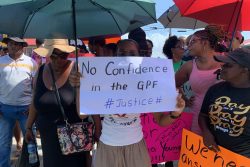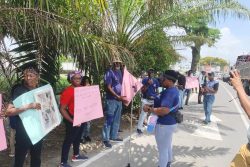As a participant and presenter I might have been biased, but I believe that by any reasonable standard the Guyana National Consultation on the Economic Partnership Agreement (EPA) held on September 5 at the National Convention Centre was a success. It would be fair to chide the organisers for not holding the event earlier and for not hosting similar events in more communities around the country before nine months had elapsed after the initialling of the EPA by the Caribbean Regional Negotiating Machinery (CRNM) in December 2007. It was not a case however, of too little too late. To the contrary, it could forcefully be claimed that better late than never, would be a fairer description of what took place. In this and the next few columns, I will assess the consultation and its aftermath as decision time for the region and formal signing of the EPA is said to be due by October 31.
Based on the self-description of those participating at the consultation, a wide cross-section of organisations was represented. These included trade unions, farmers organisations, cultural bodies, NGOs, the private sector, the media, academia, students, and political organisations.
The exchanges were vibrant. As usual in such gatherings discussion took place both at the formal sessions and in the corridors, as it were, during breaks and after the consultation formally closed.
Based on actual contributions, all shades of opinion on the EPA seemed to have gathered at the event. In particular the European Commission was a main presenter in the first formal session of the gathering. So too was the CRNM. The government was represented by the President, who participated actively during the entire proceedings. The Prime Minister and other cabinet members were also present. Indeed the Ministers of Foreign Relations and Trade and International Cooperation chaired sessions of the proceedings.
Where was Caricom?
To me, the group whose absence during the formal part of the proceedings was most noticeable, was the Caricom Secretariat. Further, no contribution was made by participants from that body on the floor. As a result, the noise caused by their absence was deafening to perceptive participants.
This was particularly unfortunate because the EPA was condemned by the vast majority of persons there, because it conflicted with the regional integration process, and in particular, the promotion of the Caribbean Single Market and Economy (CSME). As I shall argue later, this speaks volumes to the quality of economic governance in the region that this situation could have unfolded.
Remarks made in the corridors and after the gathering blamed knowledgeable persons, in particular academics and the media, for not making the public more aware of the EPA and the considerable number of weaknesses in it, which emerged in the discussions that day. This criticism astounded me, as beginning as early as January 20, 2008 I wrote 18 consecutive articles in the Sunday Stabroek on the EPA.
All the weaknesses identified in the EPA at the consultation were portrayed in those articles. Moreover, other well-known Caribbean scholars like Havelock Brewster, Norman Girvan, Vaughan Lewis, and Alissa Trotz had contributed widely circulated pieces critical of the EPA.
They had also written on the EPA for the ‘Diaspora Column’ in the Stabroek News. It would be fair to say that these criticisms were particularly disheartening as the persons expressing them are the more than average vigilant (and I supposed informed) citizens, up and around Georgetown.
Information sources
For the information of readers I repeat that the Norman Girvan website (http://www.normangirvan.info/) carries almost everything written on the EPA or provides links to these. On that website I also have an article entitled CARICOM Perspectives on the CARIFORUM–EC, EPA, which develops most of the issues touched on in my Sunday Stabroek series of columns. This article will appear shortly in the Caricom publication, CARICOM Perspectives.
This was scheduled to be available as far back as July, but I was made to understand it has encountered printing delays. Because of the circumstances outlined here I do not intend to repeat matters raised in my earlier series of columns.
For readers seriously interested in the EPA there are severe practical issues with the EPA as a legal text. For one, it is very long, over 1000 pages. The main text, however, is only 142 pages.
The balance of the document is made up of annexes, protocols and listings of products and sectors covered by the agreement. In the 142-page main text there 250 legal articles organized in six ‘Parts to the Agreement’ under four ‘Titles.’ The ‘Parts’ and ‘Titles’ are listed in the schedules below.
Parts to the EPA Agreement
Number Description
1 Trade Partnership for
Sustainable Development
2 Trade and Trade-Related
Matters
3 Dispute Avoidance and
Settlement
4 General Exceptions
5 Institutional Provisions
6 General and Final
Provisions
Source: EPA, Main Text
These Parts are laid out under the following Titles.
Titles in the EPA
Number Description
1 Trade in goods
2 Investment, trade-in-services
and e-commerce
3 Current Participants and
Capital movement
4 Trade-related issues
Source EPA, Main Text
The above schedules show how wide-ranging is the coverage of issues in the EPA. Furthermore, the text covers very technical and complex economic, financial and trade matters. It is not an easy document for lay persons to follow.
Next week I shall continue the discussion of the consultation and its aftermath from this point, noting the consensus position taken at the meeting for the Guyana government to sign on to the ‘goods-only’ parts of the EPA.









